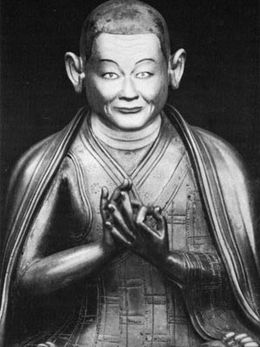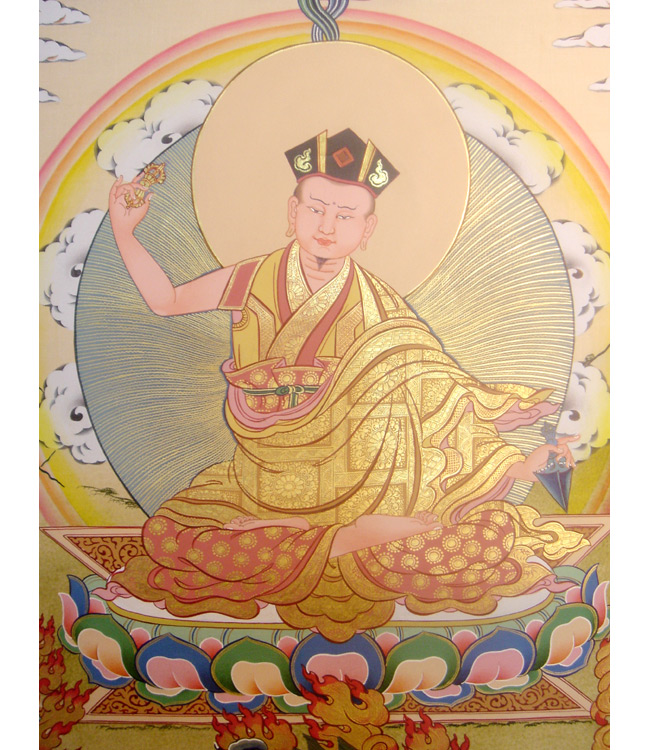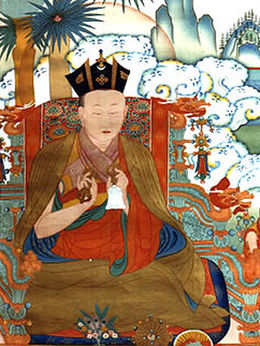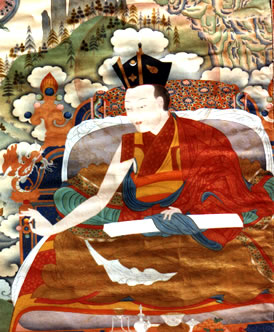
|
||||||
|
THE GOLDEN ROSARY OF THE KAGYU Reviewing the lives of our lineage ancestors, by The Karmapas In a Sutra the Buddha predicted that about 1600 years after his own death a "Man of Action" (Tibetan: Karmapa) would spread the Dharma through a lineage extending far into the future. When U Se, whom we've already mentioned as a student of Gampopa, arrived at the latter's monastery around 1140, Gampopa recognized him as the embodiment of that man. Even before that meeting, U Se, later known as Dusum Khyenpa » (Knower of the Three Times), was so advanced a practitioner that he could pass through solid rocks and mountains. Here, it is important to note that all Karmapas are considered emanations rather than reincarnations, the difference being that whereas reincarnation implies a conscious decision -- hence, a sense of an "I", however subtle -- an emanation is one hundred percent spontaneous, without ego or delay, like the rays emanating from the sun. One could say that Karmapa is a cosmic principle taking on human form, rather than a human being as we conventionally know them. Under Gampopa the Karmapa trained in the Khadampa tradition of Atisha, blended with the Mahamudra instructions of the Kagyu. He ultimately traveled and taught throughout Tibet, achieving enlightenment at age fifty while practicing Dream Yoga. Here we should examine the history of the Black Vajra Crown which, along with its accompanying ceremony, is one of the Karmapa's specialties. The legend begins in a time prior to recorded history when an emanation of Avalokiteshvara (a pre-emanation, so to speak, of Dusum Khyenpa) took on the form of a Central Asian prince. After years of solitary retreat, this prince was presented with a subtle crown, visible only to those of pure karma, woven from the hair of myriad Dakinis. Later, within recorded history, Dusum Khyenpa had a vision of Dakinis offering him this same crown. Thereafter, this crown appeared mystically above the heads of all succeeding Karmapas, but again could not be seen by ordinary beings. During the time of the Fifth Karmapa (15th century) the Chinese Emperor, Yung Lo, being a bodhisattva, could see the crown and was saddened that others could not. He therefore asked the Karmapa if he could have a replica made so all beings would beneft. The Karmapa agreed, and it was ever after considered that the mere sight of the crown had the power to liberate the viewer. We will speak more of the accompanying Black Crown ceremony when we come to the life of the Fifth Karmapa. For now, suffice it to say that at the age of eighty the first Karmapa established his seat at Tsurphu in Central Tibet, where his monastery continues to this day, although the current Karmapa has fled the Communist Chinese occupiers and is now residing in India. Dusum Khyenpa is also famous as the first being to predict his own re-emanation, thus becoming the official founder of the tulku system. Obviously, emanations and reincarnations existed long before even the appearance of Shakyamuni Buddha, but only with the Karmapa was it made official. The prediction letter was entrusted to Karmapa's chief disciple, Drogon Rechen, who was himself an early manifestation of what would later be dubbed the Tai Situ line. Dusum Khyenpa passed away at age 84, and when his funeral pyre was opened it was discovered that (as with the XVI Karmapa of our own time) some of his bones bore clear self-manifesting Buddha images. Karmapa II Karma Pakshi » was born in the 13th century into a family that was descended from the great Tibetan king, Trisong Deutsen. He was discovered according to the indications in his predecessor's letter, and was a man of many miracles. This Karmapa was invited to China by the Mongol prince, Kublai Khan, but did not stay long because the Sakyapa, who had been established in China by Sakya Pandita, resented the Kagyu master's presence and popularity. Karma Pakshi's departure to forestall sectarian violence offended Kublai who, upon later hearing that Karmapa was within his borders, sent an army of thirty thousand soldiers to arrest him. But though they tried to tie him up, Karmapa's body was like a rainbow and could not be confined. And though they forced him to drink poison, light rays streamed from his form. Nothing daunted, the soldiers then pushed him off a mountain, but he landed on a lake and glided across. Again, they tried to burn him, but streams of water issued from his body. As a last ditch stand, they locked him up for seven days without nourishment, but celestial beings brought him food. In the end, Kublai had no choice but to relent; indeed, he ultimately became Karmapa's disciple. When Karmapa returned to Tsurphu, he had a 55-foot statue of the Buddha installed there, but when completed it was found to be tilted. Aligning his body with the tilt of the statue, Karmapa gradually straightened, and as he did, so did the statute. It was Karma Pakshi who introduced the chanting -- which has since become a national leitmotif -- of the OM MANI mantra. He passed away in 1283. Karmapa III At his birth in 1284 Rangjung Dorje sat up and announced three times: "The moon has risen." He ultimately went to Tsurphu and in visions of Padmasambhava received all the teachings of the Dzogchen tantras which he united with Mahamudra teachings. Like his predecessor, he went to China and passed away there. Late that night, a palace guard saw the Karmapa's face clearly visible in the moon. Bells rang out to awaken the Emperor and Empress, who had the miracle commemorated in a carving which became one of the Emperor's most precious possessions. Karmapa IV Rolpe Dorje was born in 1340, and at the age of three told his mother, "I am the reincarnation of Karma Pakshi... In the future I will go to Tsurphu and to the imperial palace [in China] where I have many disciples." The Fourth Karmapa became a brilliant scholar who could literally absorb texts by osmosis -- that is, he would place them next to him while sleeping, and upon awakening have the information absorbed. Rolpe Dorje indeed traveled to China as he predicted, and gave a detailed and accurate account of his memories of the Emperor's palace from his previous life. In 1361 Karmapa gave lay vows to the future Tsong Khapa, who inspired the founding of the Gelukpa sect. He saw the young boy as an emanation of Manjushri and advised that he be given the best care as he would later become supremely important to Tibet. Karmapa V We have already referenced the Fifth Karmapa, Deshin Shekpa », when speaking of the mystic Black Hat Crown which Emperor Yung Lo made into a material object for the benefit of ordinary beings. It was also at this time that the Black Crown ceremony was inaugurated and became a specialty of the Karmapa line -- one of the most important aspects of their enlightened activity. During this ceremony it is said that the Karmapa assumes the form of Avalokiteshvara in response to the chanted request of his monks. After the latter recite the seven-branch prayer, Karmapa dons the crown which only he is allowed to touch, while reciting MANI mantras on a crystal rosary. Each observer is said to be blessed according to his/her personal receptivity and spiritual maturity. While at the Emperor's court, Karmapa performed a different miracle for each of one hundred days, including producing flowers that floated down from the sky, causing iridescent clouds to appear, and summoning heavenly beings. So taken was Emperor Yung Lo with Deshin Shekpa that he wanted to establish -- even if by force -- the Kagyupas as the sole sect in China. But like the present-day Dalai Lama, the Karmapa advocated the free choice of whatever teaching style best suited each student's temperament and personality. His word prevailed. Similarly, Yung Lo wished to avenge the murder of the Chinese ambassador by Tibetan bandits. But Karmapa again had the last word, preaching non-violence. Thus, because of Deshin Shekpa's peaceful persuasion, China and Tibet co-existed more or less harmoniously for three centuries of Ming Dynasty rule, with Tibet exercising autonomy over its own secular and religious affairs. Deshin Shekpa passed away in 1415. Karmapa VI Thongwa Donden was born in 1416, and passed away in his thirties. His brief life did not permit as many accomplishments as those of his predecessors, but he reviewed the entire collection of Kagyu liturgies, many of which had become fragmented, coordinated source tantras and their commentaries, and wrote many prayers still in use today. Multitalented like many of the Karmapas, he introduced Lama dances dedicated to Mahakala. Thongwa Donden was also known for his enormous and elaborate traveling encampment which his servants were trained to set up and dismantle with record speed. Most signifcantly, he gave the title of Regent, or Gyaltsap, to one of his students who thus became the first of the Gyaltsap line, The latter is responsible for overseeing the management of Tsurphu, though the present Gyaltsap, like Karmapa, currently lives in exile. Karmapa VII Chodrak Gyamtso, who was born in the 15th century and lived just past the 16th, spent much of his life in retreat so that he, like his predecessor, did not have the impact of more widely traveled Karmapas. His emphasis was on education, debate, and scholarship, such that he left a signifcant mark on the academic world of his time. He established a shedra, or monastic college, at his seat of Tsurphu, which enjoyed an exalted reputation owing to its high standards. He also advocated the broad dissemination of Buddhist texts. Karmapa VIII When Mikyo Dorje » was born in 1507, his first act was to utter the word "Karmapa." And three months later he said, "Emaho! (Oh, wonder!) I am Karmapa, do not doubt." This Karmapa's major achievement in his 47 years of life was to develop the Karma Gadri school of art (we see many thangkas of that school in exhibitions today), a form combining Indian linear values with Chinese color and Tibetan composition. He also introduced the now familiar mantra: KARMAPA KHYEN NO (Karmapa, heed me). Mikyo Dorje was also a man of miracles. At one point he sculpted a marble statue of himself, and when he asked if it was a good likeness, the figure responded, "Yes, of course." Further, he took some of the leftover marble and squeezed it like butter. These two objects were fortunately salvaged at the time of the Communist Chinese invasion and taken to the Karmapa's seat in Rumtek (Sikkim) where the late Jamgon Kongtrul referred to them as "the most important relics in our monastery." Yet another startling display of the Karmapa's mastery occurred when a huge python invaded the assembly hall of a Ladakhi palace. In response to an appeal for help, the Karmapa wrote the python a note, saying: "It is my order that you return to your own place in the lake without further ado." When this missive was read to the python, the latter shook so violently that the palace trembled. Slowly, the python unwound himself and slithered off to the lake.
*
|
|||||
© 2002 Junipur Press ALL RIGHTS RESERVED. Please contact us for permission if your wish to reproduce any material found on this site, including text, pictures and code.
 In a Sutra the Buddha predicted that about 1600 years after his own death a "Man of Action" (Tibetan: Karmapa) would spread the Dharma through a lineage extending far into the future. When U Se, whom we've already mentioned as a student of Gampopa, arrived at the latter's monastery around 1140, Gampopa recognized him as the embodiment of that man. Even before that meeting, U Se, later known as Dusum Khyenpa
In a Sutra the Buddha predicted that about 1600 years after his own death a "Man of Action" (Tibetan: Karmapa) would spread the Dharma through a lineage extending far into the future. When U Se, whom we've already mentioned as a student of Gampopa, arrived at the latter's monastery around 1140, Gampopa recognized him as the embodiment of that man. Even before that meeting, U Se, later known as Dusum Khyenpa  Karma Pakshi
Karma Pakshi  We have already referenced the Fifth Karmapa, Deshin Shekpa
We have already referenced the Fifth Karmapa, Deshin Shekpa  When Mikyo Dorje
When Mikyo Dorje